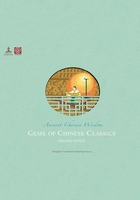
千字文 (qiān zì wén)
Thousand Character Classic
‘Alphabet song’ builds character
The “Thousand Character Classic” was used as a Chinese “alphabet song” in elementary education for more than 1,400 years. Together with the “Three Character Classic” and the “Hundred Family Surnames,” it was an integral part of the ancient “enlightenment” textbooks. Even today, many educated Chinese people can still recite some of its most popular phrases.
The idea of composing this “alphabet song” arose when Emperor Wu (464-549 AD) of the Liang Dynasty wanted a suitable book for children in the royal family to learn Chinese characters, but he found it difficult to come by. Most Confucian classics were too recondite for young children, other books too vulgar and superficial.
Therefore, the emperor first ordered a scribe to copy 1,000 unique characters from inscriptions by Wang Xizhi (303-361 AD), one of the finest calligraphers China had ever brought forth. However, those characters, though beautifully penned, were picked randomly and didn’t form a readable text, hence, it was very hard for children to memorize.
The emperor then summoned Zhou Xingsi (469-521 AD), a scholar and renowned writer, into the imperial court and asked him to compile the selected 1,000 unique characters into a text for children to read and recite.
As a child, Zhou himself was a very bright and diligent student. He traveled several hundred miles from his home village in today’s Anhui Province in eastern China to Nanjing, now capital of Jiangsu Province, to pursue his studies when he was only 13 years old. Thanks to his arduous endeavors, Zhou later became a renowned writer and he was particularly skilled at recording historical events.
After leaving the imperial court with instructions, Zhou rushed back to his home and locked himself in his study. Then, he wrote down each of the 1,000 characters on a piece of paper and began to work out presumably the world’s most difficult crossword puzzle.

It was certainly a brain-racking task to arrange 1,000 different Chinese characters into a text not only readable, but also easy to memorize. However, after burying himself among the 1,000 pieces of paper for the whole night, when the first light of the new day dawned through his study window, Zhou stood up, holding in his hand a newly compiled text that would be read and recited by billions of Chinese children in the following 14 centuries.
Zhou divided the 1,000 characters into 250 four-character phrases with a melodious rhythm. Therefore, it could be sung in an almost identical way of Western children singing the “alphabet song.”
Then, the whole text was divided into four parts covering topics including the earth and the sky, mountains and rivers, farming and history, ethics and code of conduct, friendship and loyalty, government and social services, and countryside and idyllic life.
When Zhou handed his work to the emperor that morning, the ruler was pleasantly surprised that it was completed in such a short time, and after reading the text, he became very excited, saying that it was a good job and miracle.
Later, the “Thousand Character Classic” was not only very popular in China, but also well-received in Japan and some other East and Southeast Asian countries.
In the text, “洁”(clean) is the only character that is repeated, but only once. Many Chinese scholars in the following centuries attempted to improve the text to avoid the only repetition, but none of them succeeded.
However, because of its beautiful phrases and 1,000 (999 in fact) unique characters, it also becomes a favorite subject for Chinese calligraphy. Hundreds of famous scholars, calligraphers and even emperors have left behind numerous great works of calligraphy, copying out the “Thousand Character Classic.”